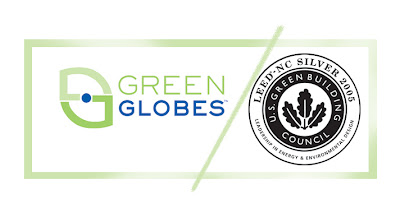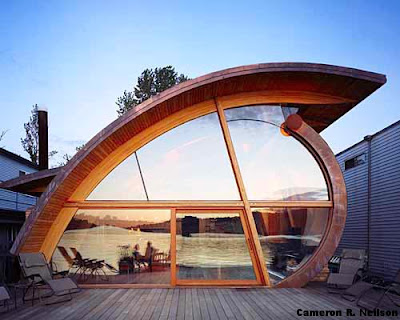LEED and Green Globes

What are LEED and Green Globes ? They are a web-based rating tools that evaluates Green Building and provides a suite of standards for environmentally sustainable construction. The systems allows a project team to receive real-time feedback and recommendations for increased performance of the projects.
what are the differences between LEED and Green Globes ?
Green Globes has been around since 1991- it was introduced in Europe, then came to Canada, and is now administered in the U.S. by the Green Building Initiative. It awards 1,000 points across seven credit categories- project management (50), site (115), energy (380), water (85), resources (100), emissions (70), and indoor environment (200). Projects that earn 35% of the 1,000 points receive one globe, 55%, 70%, and 85% receive two, three, and four globes, respectively. It Designed for use on building projects of any size, the Green Globes system is suitable for everything from large and small offices and multi-family structures, to institutional buildings such as schools, universities and libraries. The Green Globes suite of tools is used to integrate sustainability goals into new construction, renovations, and entire building portfolios.
The Leadership in Energy and Environmental Design (LEED) Green Building Rating System is a benchmark for the design, construction, and operation of high performance green buildings. LEED gives building owners and operators the tools they need to have an immediate and measurable impact on their buildings’ performance. LEED promotes a whole-building approach to sustainability by recognizing performance in five key areas of human and environmental health: sustainable site development, water savings, energy efficiency, materials selection, and indoor environmental quality.
What is LEED Certification?
The first step to LEED certification is to Register your project. A project is a viable candidate for LEED certification if it can meet all prerequisites and achieve the minimum number of points to earn the Certified level of LEED project certification. To earn certification, a building project must meet certain prerequisites and performance benchmarks ("credits") within each category. Projects are awarded Certified, Silver, Gold, or Platinum certification depending on the number of credits they achieve. This comprehensive approach is the reason LEED-certified buildings have reduced operating costs, healthier and more productive occupants, and conserve our natural resources.
What's unique about the Green Globes system?
There is much agreement with regard to what constitutes best energy and environmental practices, so the major green building standards—such as Green Globes, LEED, BREEAM, the GBC tool, and the Minnesota Design Guidelines—have more similarities than differences. However, the Green Globes system does have a number of distinct attributes. Too often, designers make their projects green by adding expensive technologies after many of the important decisions are made. This is costly as well as ineffective. In addition to being easy to use and affordable, Green Globes encourages designers to consider the elements of green design and sustainability early in the project. Because it generates a report written in plain language, Green Globes also promotes interaction between the building designers and client. Among its other attributes, it introduces users to the idea of incorporating Life Cycle Assessment into the decision making process for resource and material selection, encourages the use of EPA's EnergyStar Target Finder for developing building energy benchmarks, and gives points for using an integrated design process, addressing acoustical comfort, minimizing opportunities for pest intrusion, and reducing emissions and effluents.
How much does Green Globes cost?
Priced at $500.00 per self-assessment, Green Globes is less expensive than other rating systems. To have a building third-party verified, there is an average additional total cost of $4,000-$5,000, which includes a conditional verification—at the construction documents stage—and final verification after a site inspection is conducted. Prices currently in use are for the U.S. pilot program and are subject to change.
Why is Green Globes ideal for smaller projects?
The Green Globes system can be used with any size building. However, because of its flexiblity, it's easy to apply to smaller, lower budget buildings—and, in fact, one of our goals is to ensure that it remains affordable for smaller projects that can't justify an expensive assessment. You can also perform the assessment in-house (or anywhere there's Internet access), allowing you to try several schematics to see which offers the best results. The Green Globes system also offers practical resources for designing better performing buildings.
LEED is a popular guide for green building in the United States and it is developed and continuously modified by workers in the green building industry. Some criticism suggests that while the LEED rating system is sensitive to local environmental conditions, its checklist system does not vary by the local environmental conditions enough (for instance, a building in Maine would receive the same credit as a building in Arizona for water conservation, though the principle is more important in the latter case). Another complaint is that its certification costs require money that could be used to make the building in question even more sustainable. Many critics have noted that compliance and certification costs have grown faster than staff support from the USGBC.
Green Globes doesn’t require a construction team to generate any additional paperwork outside of that which is already produced on the project. For LEED, you have to produce things you normally don’t in construction. Green Globes provides feedback to design teams during each phase of the project and each time you do that the system gives a feedback. It’s a great tool for first year engineers and architects.
Green Globes competes with the better known, more cumbersome and more expensive LEED system from the US Green Building Council.
According to a study by the University of Minnesota "nearly 80 percent of the categories available for points in Green Globes are also addressed in LEED 2.2 and that over 85 percent of the categories specified in LEED 2.2 are addressed in Green Globes." The same study indicated that there was only moderate dissimilarity between the rating standards, but that LEED has a slightly greater emphasis on materials choices and Green Globes has a slightly greater emphasis on saving energy.
Numerous buildings have been evaluated with both systems. In all but two of the instances, the systems have generated comparable ratings. The other two buildings were only marginally different.
The primary differences between the two approaches then boil down to ease of use and cost.
According to the University of Minnesota study "From a process perspective, Green Globes' simpler methodology, employing a user-friendly interactive guide for assessing and integrating green design principles for buildings, continues to be a point of differentiation to LEED's more complex, and largely paper-based system. While LEED has recently introduced an online-based system, it remains more extensive and requires expert knowledge in various areas. Green Globes' web-based self-assessment tool can be completed by any team member with general knowledge of the building's parameters." The researchers added that, "In contrast, LEED tends to be more rigid, time-intensive, and expensive to administer."


Comments
Any input to shed light upon this would be greatly appreciated!